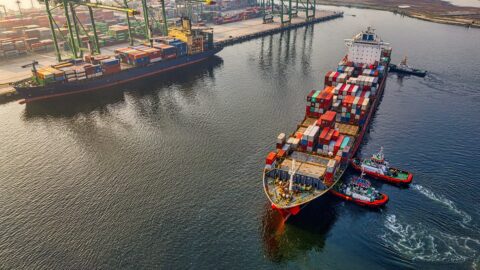Summary: The economic recovery in the developed economies is supported by the very expansive monetary policies, lower austerity pressure on the government front and among banks, and the fallen oil price. Growth rates remain moderate. In the emerging markets we can see signs of low-level stabilisation at best. The possible default of Greece, excessive interest rate hikes in the USA, a further decline of productivity, and continued economic weakening in the emerging markets are the main risks the markets are faced with.
What are the details?
High Noon with Greece
The current bailout programme with Greece is about to expire at the end of June. The new government in Greece has not accepted the terms of the programme right from the start. It hopes that the creditors will agree to a new programme with more favourable terms for Greece. It would be a rational move to reach an agreement both for the institutions and for Greece, with massive welfare losses and chaos in Greece as well as spill-over effects and the increase of the disintegration risk in the Eurozone looming in the absence of an agreement. It should be possible to reach a compromise between austerity and haircut if both parties are negotiating in good faith.
Nevertheless, a possible default and an ensuing exit from the Eurozone would not come as a surprise to anyone anymore at this point. The instruments of the central bank – unlimited provision of liquidity for a country in case of emergency and the bond purchase programme – restrict possible spill-over effects to equities and government bonds. Still, in the event of a default, risky assets are likely to incur temporary losses. In Greece, capital control would be implemented, and savings would be frozen. The Greek government would probably use (worthless) vouchers for its expenses at the beginning. In this scenario, new elections are realistic. But even in case of an agreement in the eleventh hour a sustainable solution is unlikely. After the crisis is before the crisis. Here one of the weaknesses of the Eurozone becomes apparent: the lack of the necessary institutions that would facilitate a common economic and financial policy. The countries of the Eurozone are not irrevocably tied to each other.
From trend to volatility
Some important trends have come to an end in the first half of the year and have given way to increased volatility. The yields of bonds and the oil price have not fallen further, and the US dollar and the share prices have not increased any more. Where are we going next?
Weak growth
After a weak first quarter initial signs are indicating a slightly higher growth rate of real GDP for Q2. This is mainly due to the improved economic activity in the USA after it had shrunk slightly in Q1. Overall, however, global growth remains modest because the growth rates of industrial production, of retail sales, of exports, and company investments remain subdued on a global scale. In the emerging markets especially, a number of leading indicators are suggesting sustainably weak growth.
Boom in the Eurozone
Even if it does not feel that way: technically speaking, the Eurozone is currently in a boom phase. The Eurozone economy grew by an annualised 1.5% on a quarter-on-quarter basis. For Q2 indicators suggest a growth rate of 2%. This would mean a full percentage point above the estimated long-term average growth rate.
Improvement on the labour market
In this environment employment growth has improved in some developed economies. This implies the deterioration of labour productivity, i.e. the relationship between production and employment. Accordingly, wage inflation in the USA and the UK has increased slightly.
Market correction
The increase in yields, or actually, the decline in prices of many government bonds between the end of April and the beginning of June has caused uncertainty among many investors. Generally speaking, the more exhausted the valuation potential, the more susceptible the asset class is to a correction. The decline in liquidity on the government bond market exacerbates this characteristic.
In Germany, the real yield (i.e. nominal yield minus priced-in inflation) of a maturity of ten years amounted to -1.37% in mid-April. At the same time the economic data have increasingly suggested a cyclical recovery in the Eurozone. In line with this situation, real yields have increased (to -0.30% at the beginning of June). However, the recovery in the Eurozone is not self-supporting. One condition for this to be the case is a low level of interest rates and yields. At this point, it is realistic to expect negative real yields in the Eurozone for a sustainable period of time. It is too soon for an increase towards the long-term fair level of about 1%. This has been achieved by the indication put forth by the ECB to keep the key-lending rates at zero percent for the foreseeable future (N.B. the interest rate on deposits is even negative) and by the bond purchase programme.
At 1.9 percentage points, the yield differential between 10Y Treasury bonds in the USA and German government bonds has reached the highest level since 1989. At the same time the expectations for the increase of the Fed funds rate in the USA have fallen. The Fed is signalling that it wants to raise the Fed funds rate, but that it will be going about this step very carefully. The interest hike cycle will be no case of a lift-off; instead we will see a “crawling” scenario. The attractiveness of US Treasury bonds has therefore increased in comparison with German government bonds.
The yield differential between 10Y government bonds in Japan and Germany turned negative in February for the first time, and reached -0.24% in April. The attractiveness of German government bonds has therefore decreased in comparison with Japanese government bonds.
The increases in yields are largely of a technical nature. The economic environment suggests sustainably low yield levels. Investors will have to get used to bigger price fluctuations because valuations have no upward potential left, i.e. are expensive.
Oil price: too high?
Oil production remains in excess of demand. The difference disappears in massive building of stocks. As soon as they are full, the oil price will come under pressure if demand does not pick up or production is reduced.
US dollar: appreciation has come to an end
The main reason for the significant appreciation of the US dollar vis-à-vis many other currencies in the second half of 2014 was the expectation of a clear increase of the Fed funds rate in the USA. However, these expectations have fallen. Since March the US dollar has been consolidating.
Conclusion
The economic recovery in the developed economies is supported by the very expansive monetary policies, lower austerity pressure on the government front and among banks, and the fallen oil price. Growth rates remain moderate. In the emerging markets we can see signs of low-level stabilisation at best. The possible default of Greece, excessive interest rate hikes in the USA, a further decline of productivity, and continued economic weakening in the emerging markets are the main risks the markets are faced with.
Legal disclaimer
This document is an advertisement. Unless indicated otherwise, source: Erste Asset Management GmbH. The language of communication of the sales offices is German and the languages of communication of the Management Company also include English.
The prospectus for UCITS funds (including any amendments) is prepared and published in accordance with the provisions of the InvFG 2011 as amended. Information for Investors pursuant to § 21 AIFMG is prepared for the alternative investment funds (AIF) administered by Erste Asset Management GmbH pursuant to the provisions of the AIFMG in conjunction with the InvFG 2011.
The currently valid versions of the prospectus, the Information for Investors pursuant to § 21 AIFMG, and the key information document can be found on the website www.erste-am.com under “Mandatory publications” and can be obtained free of charge by interested investors at the offices of the Management Company and at the offices of the depositary bank. The exact date of the most recent publication of the prospectus, the languages in which the fund prospectus or the Information for Investors pursuant to Art 21 AIFMG and the key information document are available, and any other locations where the documents can be obtained are indicated on the website www.erste-am.com. A summary of the investor rights is available in German and English on the website www.erste-am.com/investor-rights and can also be obtained from the Management Company.
The Management Company can decide to suspend the provisions it has taken for the sale of unit certificates in other countries in accordance with the regulatory requirements.
Note: You are about to purchase a product that may be difficult to understand. We recommend that you read the indicated fund documents before making an investment decision. In addition to the locations listed above, you can obtain these documents free of charge at the offices of the referring Sparkassen bank and the offices of Erste Bank der oesterreichischen Sparkassen AG. You can also access these documents electronically at www.erste-am.com.
Our analyses and conclusions are general in nature and do not take into account the individual characteristics of our investors in terms of earnings, taxation, experience and knowledge, investment objective, financial position, capacity for loss, and risk tolerance. Past performance is not a reliable indicator of the future performance of a fund.
Please note: Investments in securities entail risks in addition to the opportunities presented here. The value of units and their earnings can rise and fall. Changes in exchange rates can also have a positive or negative effect on the value of an investment. For this reason, you may receive less than your originally invested amount when you redeem your units. Persons who are interested in purchasing units in investment funds are advised to read the current fund prospectus(es) and the Information for Investors pursuant to § 21 AIFMG, especially the risk notices they contain, before making an investment decision. If the fund currency is different than the investor’s home currency, changes in the relevant exchange rate can positively or negatively influence the value of the investment and the amount of the costs associated with the fund in the home currency.
We are not permitted to directly or indirectly offer, sell, transfer, or deliver this financial product to natural or legal persons whose place of residence or domicile is located in a country where this is legally prohibited. In this case, we may not provide any product information, either.
Please consult the corresponding information in the fund prospectus and the Information for Investors pursuant to § 21 AIFMG for restrictions on the sale of the fund to American or Russian citizens.
It is expressly noted that this communication does not provide any investment recommendations, but only expresses our current market assessment. Thus, this communication is not a substitute for investment advice.
This document does not represent a sales activity of the Management Company and therefore may not be construed as an offer for the purchase or sale of financial or investment instruments.
Erste Asset Management GmbH is affiliated with the Erste Bank and austrian Sparkassen banks.
Please also read the “Information about us and our securities services” published by your bank.

